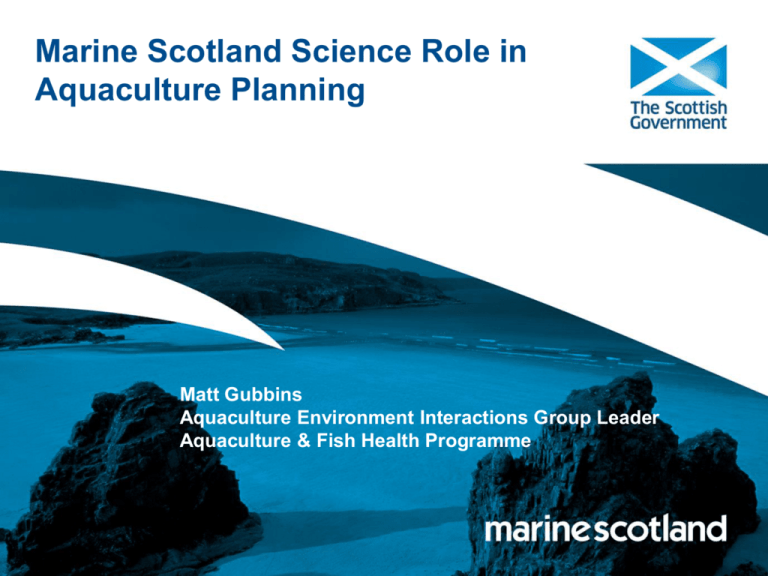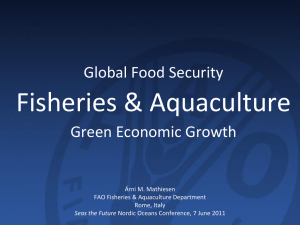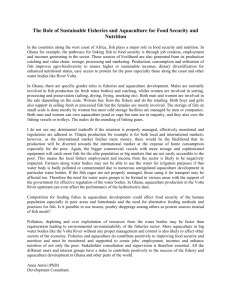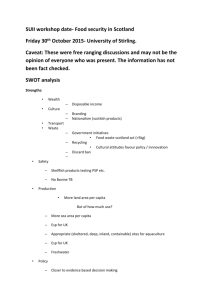Open - The Scottish Government
advertisement

Marine Scotland Science Role in Aquaculture Planning Matt Gubbins Aquaculture Environment Interactions Group Leader Aquaculture & Fish Health Programme Contents • Marine Scotland – structure • Marine Scotland Science – role in aquaculture regulation • Statutory Consultee for Planning – Environmental issues – Wild fisheries issues – Fish health & containment issues • Working arrangements Marine Scotland Performance / Aquaculture •Aquaculture Planning •Aquaculture & Fish Health Science •Fish Health Inspectorate •Aquaculture Environment Interactions •Freshwater Laboratory Planning and Policy •Licensing Operations Team •Marine Planning & Licensing Compliance Fisheries Division Marine Scotland Science Science Director Marine Assessments Programme Aquaculture & Fish Health Programme Freshwater Programme Marine Ecosystems Programme Marine Analytical Unit Aquaculture and Fish Health Programme – – – – – – – – Fish Health Inspectorate Aquaculture Environment Interactions Pathology and Bacteriology Virology Molecular Genetics Epidemiology Infection & Immunity Aquarium Services – Research Station - Aultbea MSS Freshwater Laboratory, Faskally, Pitlochry • FL is responsible for monitoring the status of migratory and freshwater fish populations in Scotland. • Conduct research in support of scientific advice provided to the Scottish Government in order to help protect fish and promote the development of sustainable fisheries • Contribute to the salmon management activities of the International Council for the Exploration of the Sea (ICES) and to the North Atlantic Salmon Conservation Organisation (NASCO). • Focus on salmonids – Atlantic salmon and sea trout • Base for Scottish Fisheries Coordination Centre. Collaborate with DSFBs, Fishery Research Trusts and Foundations, angling bodies, TWG MSS Role in Aquaculture Regulation Fish Health Inspectorate 1. Health of farmed fish under The Aquatic Animal Health (Scotland) Regulations 2009 2. Containment and parasite (sea lice) control under The Aquaculture and Fisheries (Scotland) Act 2007 A surveillance program of inspections is conducted under this legislation. 3. Authorisation of all Aquaculture Production Businesses (APB's) under The Aquatic Animal Health (Scotland) Regulations 2009. Applications for authorisation should be made to the FHI and authorisations will be issued subject to businesses meeting certain conditions. All new fish and shellfish farms are required to apply for authorisation before any development takes place. Licensing Operations Team • Food Environment Protection Act, 1985 (II Deposits in the sea) (FEPA) – – – – – Wellboat discharges of sea lice bath treatments 5 vessels licensed 47 licenses, multiple cage sites BPEO assessment Consultation SNH, SEPA • Coast Protection Act (1949) – Section 34 consent – Navigation issues – Issued by Ports and Harbours Branch • Marine Licence – Marine (Scotland) Act 2010 – Spring 2011 Consultee / Advisory role • Controlled Activities Regulations, 2005 (SEPA) • Advice to Scottish Ministers on appeals / call-ins • Statutory Consultee TCPA / EIA Regulations – Pre-application consultation – – – – Locational Guidelines viewpoint Scenario modelling Environmental data for EIA Management Area issues – EIA Screening and Scoping (finfish only) – EIA / Planning applications MSS Statutory Consultee – Working Arrangements Single Point of Contact – Paul Stainer, Licensing Operations Team (LOT) Planning Coordinator – Anna Turnbull, Aquaculture Environment Interactions Internal Consultation • ‘Environmental’ and shellfish issues Aquaculture Environment Interactions Group 2) Fish health and welfare issues Fish Health Inspectorate 3) Wild fisheries issues Freshwater Programme, Freshwater Laboratory, Pitlochry Environmental issues (EIA) • Aquaculture Environment Interactions Group • Nutrient enrichment – Estimated enhancement (modelling) – Sea loch / open coastal – Cumulative effects • Locational Guidelines – Capacity estimates – Category 1 ‘limit’ Locational Guidelines • Lochs, voes, bays etc. • Predicted current impacts from fish farms • Modelled nutrient enhancement • Modelled benthic impact • Combined index • Ranking of water bodies • Precautionary • Directs new developments • Categories 1, 2, 3 • Updated quarterly http://www.scotland.gov.uk/About/Directorates/Wealthier-and-Fairer/marine-scotland Category 1 areas West coast / Western Isles (5 areas) Shetland (12 areas) Environmental issues (EIA) – Chemical/medicine usage • Sufficient licensed chemotherapeutants without breaching EQS? • Treatable biomass (in-feed), time to treat site (bath treatments) • Modelling done for CAR – Benthic impacts (monitoring/modelling) • Levels of impact acceptable? – Historical benthic surveys – AutoDEPOMOD modelling (CAR) • Cumulative / remote impacts? Environmental issues – Working Arrangements Local Authority MSS Central Contact MSS Central Contact AEI SNH SEPA • Avoids conflicting responses (concensus) • Avoids superfluous requests for environmental data • Requires long consultation periods Fish Health, Containment and Sea Lice (Planning) Katy Urquhart Fish Health Inspectorate (FHI) comment on: • disease risk implications, • fish health and welfare, • sea lice control • containment Considerations: • Location and proximity to other aquaculture sites – Comment on any sites within 1000m • MSS disease Management Areas • Surveillance and control of notifiable diseases – Check existing MA’s won’t conjoin – State which MA site will be in and advise to operate within agreement with all operators in this area (synchronous fallowing and treatments, single year class) Fish Health, Containment and Sea Lice considerations contd. (Planning) Stocking and husbandry techniques • Species to be stocked – generally against multiple fish species, Stocking density – below 22 kg/m3 used as a guide • Mortality removal procedures and frequency of these procedures. Also method of disposal of mortalities. Sea lice • Treatments consented for use and method of administration • Other non treatment based strategies in place for controlling sea lice – operating as part of AMA – synchronous fallowing – single year class – biological control Fish Health, Containment and Sea Lice considerations contd. (Planning) Containment • Equipment in use to minimise predator interactions • Contingency plan detailing actions to be taken in event of an escape – – • Physical actions to prevent further escape Paperwork e.g. notifications Suitability of equipment (cages, moorings and nets) in use at site in question – Attestation from suppliers or suitably qualified individual – OR – Equipment specifications detailing the environmental conditions the cages and moorings can withstand in combination with details of the environmental conditions experienced at the site location. Wild fisheries issues (EIA) Alisdair MacDonald / Mike Miles MSS Freshwater Laboratory considers: • Potential impacts of disease and parasites on wild fish resulting from the presence of fish farms • Impacts of escaped farmed fish through inter-breeding and competition with wild fish • Introduction of non-native farmed species Wild fisheries issues contd. (EIA) Alisdair MacDonald / Mike Miles The factors taken into account are: • Site location in relation to migratory salmonid rivers. • Proposed / existing levels of sea lice control. • Membership of a Farm Management Agreement and AMA. • Evidence of the adherence to the industry Code of Good Practice. • Presence of a robust containment and escapes contingency plan. Wild fisheries issues – Working Arrangements Local Authority MSS Central Contact MSS Central Contact FL SNH DSFB • Targeted cases • Share data / opinions Shellfish Issues (Planning) • Environment – Biological capacity estimates – Risk assessments based on tidal flushing vs filtration – Seabed impacts • Disease / containment – Co-culture with finfish – Crassostrea gigas containment • Shellfish hygiene – Algal toxins – Bacterial contamination (classification) – Depuration facilities Supporting staff • • • • • • • • • • • Anna Turnbull (Aquaculture Planning Coordinator) Paul Stainer (Planning administrator) Matt Gubbins (Aquaculture Environment Interactions) Charles Allan (Fish Health Inspectorate) Katy A Urquhart (Fish Health Inspectorate) Jacqueline Parker (Fish Health Inspectorate) Alisdair MacDonald (Freshwater Laboratory) Mike Miles (Freshwater Laboratory) John Armstrong (Freshwater Laboratory) Shona Kinnear (Shellfish Hygiene) John Turriff (Shellfish Hygiene)








